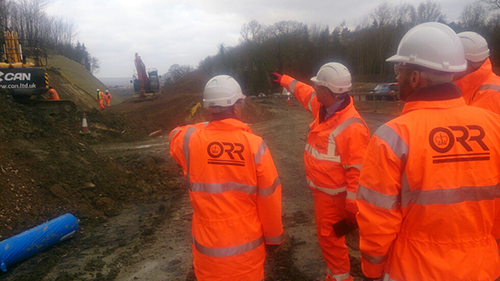The government’s major improvements investment plan (set out in the 5-year Road Investment Strategy published in 2014) is not just about increasing capacity and improving traffic flow on our motorways. Just over half of the 112 schemes focus on upgrades to major A roads, where delays can be the most frustrating for road users and traffic is often in close proximity to residents and natural habitats.
ORR’s role in this is to hold Highways England to account for delivering the £15 billion programme of road schemes. Site visits are a useful way to understand the challenges that the company and its contractors face, and how these can be managed to improve future projects.
Last week, ORR visited the A21 Tonbridge to Pembury dualling scheme, which is nearing completion. This notorious three mile single-carriageway bottleneck between two pieces of dual carriageway on the main road link from the M25 to Hastings carries 35,000 vehicles per day. That’s way beyond its design capacity. It also has a high accident frequency rate. Side roads and properties have direct access to the main carriageway with no merging provision. Much of the road is undulating and twisting, with trees and vegetation up to the roadside.
 The solution, which Balfour Beatty is building, completes the missing dual carriageway link. It closely follows the old road alignment to keep habitat destruction to a minimum. There’s a new grade-separated junction at its southern end, grade-separated access from side roads, and a cycle route alongside the road. With additional funding from Kent County Council, the cycle route will connect to Tonbridge station. The scheme will be completed this summer. Much of the earthmoving and carriageway construction is finished, and the major structures are now taking shape.
The solution, which Balfour Beatty is building, completes the missing dual carriageway link. It closely follows the old road alignment to keep habitat destruction to a minimum. There’s a new grade-separated junction at its southern end, grade-separated access from side roads, and a cycle route alongside the road. With additional funding from Kent County Council, the cycle route will connect to Tonbridge station. The scheme will be completed this summer. Much of the earthmoving and carriageway construction is finished, and the major structures are now taking shape.
Building the new road has been no easy task. Partly due to its complexity, it has been in and out of roads programmes since Roads for Prosperity in 1989. There’s a scheduled monument at Castle Hill, ancient coppiced woodland, and listed buildings, all in the High Weald Area of Outstanding Natural Beauty. Where habitat has been removed because of the scheme, every one acre lost will be replaced by two, with original soil and roots translocated. An Environmental Advisory Group has overseen this and other conservation work, and its role in the decision making process has attracted interest from others including HS2.
Not everything has gone smoothly. The sensitive wooded site meant ground investigations were not as comprehensive as they could have been. As a result, the extent of contaminated land at the site was not fully understood, and the ground water levels and site geology more complex than expected. Woodland translocation and moving protected species such as dormice could only occur at certain times of the year. Statutory utility diversions, programmed well ahead of the start of the project, were delayed. This all has had a knock on effect on the completion date for the scheme, which has been pushed back from the spring.
Our biggest takeaway was the importance of pre-construction surveying and investigation, particularly in such challenging areas. We will expect Highways England to learn these lessons for future projects.


